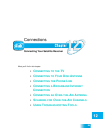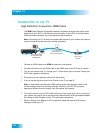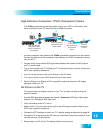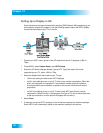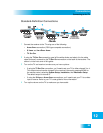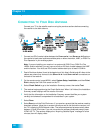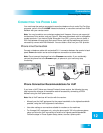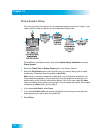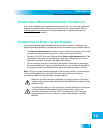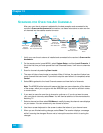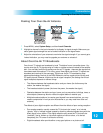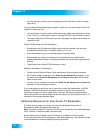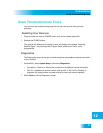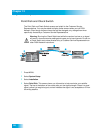
96
Scanning for Over-the-Air Channels
Chapter 12
• You may be able to receive a poor analog signal but not be able to receive a digital
signal at all.
To get the best possible digital signal reception, make sure you use the best over-the-air
antenna for where you live:
• You can receive a limited number of channels using a rabbit ears type antenna on top
of the TV set, or a much larger number via a large UHF/VHF indoor/outdoor antenna.
• The higher the quality of the antenna you use, the greater its range and the better its
reception will be.
Digital OTA Broadcasts are Still Developing
• Broadcasters may still be testing digital signals and their strength, and may stop
broadcasting without notice, vary power output, or turn it off.
• Some broadcasters do not yet have permanent transmitter tower.
• Broadcasters may choose to multicast, which allows them to provide multiple
standard-definition channels in the same bandwidth used to provide a high-definition
channel.
• These factors are outside of DISH Network's control.
Additional Installation Considerations
• Follow local and National Electric Code requirements for grounding the antenna.
• RG-6 coaxial cable is preferred for the O
VER THE AIR ANTENNA IN connection. If you
are diplexing the O
VER THE AIR ANTENNA IN and SATELLITE IN cables, RG-6 coaxial
cable must be used.
• You can not use a diplexer to combine the O
VER THE AIR ANTENNA IN and SATELLITE
I
N cables if using an amplified antenna.
If you have questions about over-the-air channels, contact the broadcasters, not DISH
Network. DISH Network does not broadcast over-the-air signals and so cannot do
anything to change over-the-air signal quality. However, the receiver's digital channel
setup menus provide a signal strength bar that can help you in aiming the over-the-air TV
antenna for the strongest possible signal.
Additional Resources for Over-the-Air TV Broadcasts
For information on channel numbers, you can visit the National Association of
Broadcasters (NAB) web page at www.nab.org.
Note: The receiver displays “Transmit Channel” which is referred to on the NAB web page
as RF Channel. These terms mean the same thing.
Another good source of local channel information is available from the Consumer
Electronics Association (CEA) web page at: www.antennaweb.org. This website provides
recommendations for antenna types and pointing directions.



